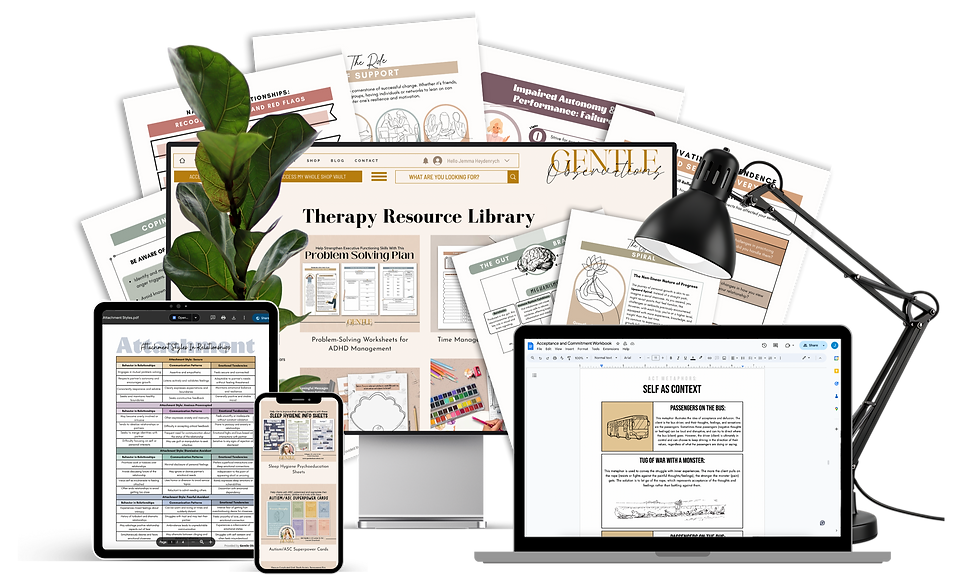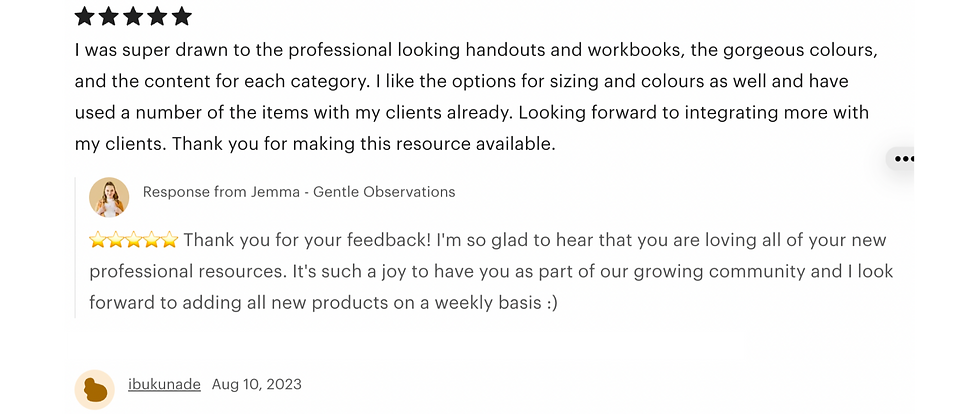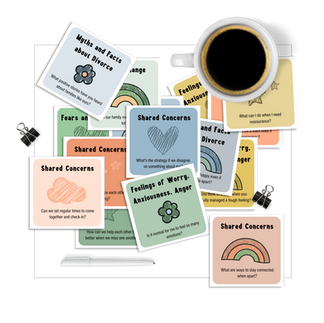The Therapy Resource Library
- Monique McNamara
- Nov 10, 2024
- 9 min read
Updated: Nov 12

Less Scramble, More Presence
Back-to-backs. Charting. “Final_final_3.docx.” If your prep lives between sticky notes and midnight formatting, you’re not alone. We built the Therapy Resource Library so you can walk into sessions calm, prepared, and client-focused—without reinventing the wheel every week.
Prep in minutes, not hours. Search, tweak, and go with clinician-made tools you can actually use tomorrow.
Proof, at a glance: 8,000+ tools · $1,500+ value · +$360–$600/yr added · Editable Google Docs & Word · Fillable PDFs · Telehealth-ready
Explore the Therapy Resource Library See what’s inside. It’s more than just a collection of tools; it’s a time-saving solution that makes therapy more efficient, giving you the space to focus on your clients—and yourself.

A letter to fellow therapists (why this exists)
We see you. We’ve been you. Back-to-backs that blur into each other. Notes waiting after dark. That 8 a.m. anxious teen you care deeply about—and the 11 p.m. scramble to make something that actually lands. The folder called final_final_3.docx? Same.

The night that tipped it over
My turning point was a Tuesday that ran long. Sticky notes everywhere. Ten tabs open with “maybe” worksheets that were either too generic, too clinical-jargony, or… ugly. I was formatting in Word at 11:12 p.m., resizing a table cell so it wouldn’t push onto page three. I remember thinking: I can give better care than this. I just need better tools—and I need them now.

So I started making the things I couldn’t find:
Worksheets that spoke human, not just clinical.
Visuals that got buy-in, not eye rolls.
Options for kids, teens, adults, and couples that felt age-appropriate and kind.
Versions I could edit fast in Google Docs/Word and share as fillable PDFs in telehealth without a tech headache.
What I wished existed
A single home for everything:
Search by age, condition, or modality and get something relevant in 30 seconds.
Clean design clients actually want to use.
Tools that respect clinical judgment and can be tailored in minutes—language, examples, branding, all yours.
A library that keeps growing with real-world feedback, not just theory.
When I couldn’t find it, I built it, and kept building as colleagues asked, “Do you have something for…?” ADHD, Autism, grief and aging, anxiety, trauma, self-esteem, boundaries, relationship skills—the list got long because caseloads are wide.
It’s now a living library of 8,000+ tools (current value $1,500+), with $30–$50 of new resources added every month (≈ $360–$600/yr). Every piece is:
Editable (Google Docs/Word) so you can adapt language, examples, and look-and-feel.
Telehealth-ready (fillable PDFs or live-edit Docs).
Organized with advanced search + filters so you can find the right thing fast.
Why therapists say it helps
Because the pain is real:
Time debt: You care a lot. Prep steals evenings. We give you back hours.
Decision fatigue: 20 tabs, 5 carts—no unified system. We’re the one home.
Engagement worries: “Will this connect?” Clean visuals and plain language help.
Telehealth friction: Sharing that actually works mid-session.
Design drag: No more pixel-pushing at midnight.
And the community keeps shaping it:




Our promise (therapist to therapist)
Evidence-informed, clinically respectful, human-sounding tools that save time without watering down the work. You bring your training and judgment; we bring a ready starting point you can personalize in minutes.
And importantly, this Library is bigger than anything we could have built alone. We’ve listened—to your emails, DMs, supervision needs, school counseling realities, private-practice wish lists. Many resources exist because you asked for them: ADHD/Autism-specific tools, grief & aging supports, clearer CBT handouts, friendlier IFS worksheets, telehealth-ready versions, classroom-safe visuals. Your requests and suggestions shape what we make next, every month.
It’s not just a library; it’s a co-created toolkit for real caseloads—growing with you, informed by you, and designed to give you back time where it matters most.
2) The real problems (and how we relieve them)
What hurts (you’re not alone)
Time debt: Back-to-backs, notes, and “what am I using at 8 a.m.?” leave prep for after-hours.
Decision fatigue: 20 tabs open, 5 carts started, nothing that’s exactly right.
Engagement worries: “Will this land with this client?” (Different ages, cultures, literacy levels.)
Telehealth friction: Non-fillable PDFs, clunky screen shares, lost momentum.
Design drag: You trained as a clinician, not a typesetter—yet here you are nudging tables at 11 p.m.
How the Library lightens the load
Find fast: Use search and filters by age, condition, modality to land on a fit in under a minute—no tab maze.
Customize quickly: Open in Google Docs/Word, tweak language, examples, or tone; add your logo and you’re done.
Telehealth-ready: Share fillable PDFs for homework or co-edit live in Docs during session—keeps clients engaged.
Clean design = buy-in: Client-friendly visuals and plain language reduce resistance and increase “I can do this.”
One home for everything: 8,000+ tools (current value $1,500+) with $30–$50/mo of new resources (≈ $360–$600/yr)—no more scattered downloads.
“I just download what I need.” “Made more financial sense than buying one-offs.”
Gentle nudge: want to see how quickly you can find a match for tomorrow’s caseload? Browse what’s inside.
3) What’s inside (at a glance)
Formats
Editable: Google Docs & Word (change wording, examples, branding)
Digital-ready: Fillable PDFs for homework + telehealth
Types
Worksheets · Workbooks · Handouts · Assessments
Coping skills cards · Affirmations · Posters
Question cards · Games
Demographics
Children · Adolescents · Adults · Couples · Groups
Conditions / Topics
ADHD · Autism · Anxiety · Depression
Trauma / PTSD · Grief & Aging · Emotional Regulation
Self-Esteem · Boundaries · Social Skills
Stress & Burnout · Substance Use · Values & Motivation
Shame & Guilt · Relationship Skills
Therapy Approaches
CBT · DBT · ACT · IFS
Mindfulness · Schema · Somatic · Polyvagal
Narrative · Solution-Focused (SFT) · Art Therapy · Attachment-informed
Language
English (US)
“Clean design and plain language = better client buy-in. They actually want to use the sheets.”
You’ll find 8,000+ tools (current value $1,500+) with $30–$50/mo of new resources (≈ $360–$600/yr).
4) “Will it help me this week?” (mini-scenarios with higher-level tools)
Private practice (8 a.m. teen anxiety) Your teen arrives keyed up and avoidant. You open the Anxiety Skills Mini-Curriculum (session-by-session outline), co-complete a CBT Thought Reframe Workbook page, and assign the Worry → Plan Fillable Toolkit for between-session practice. Ten minutes of prep; the rest is attunement.
School counselor (tiered support, morning block) You’ve got a Grade 6 group plus two classroom drop-ins. You run Week 3 from the Emotion Regulation Small-Group Curriculum, send teachers a Calm Corner Implementation Pack, and give students Coping Skills Card Decks for daily use. Teachers email: “Fewer disruptions by lunch.”
Couples & family (repair + values) High conflict, low hope. You start with the Couples Repair Roadmap (stepwise protocol), use the Values & Boundaries Card Sort to surface alignments, then co-build a 7-Day Micro-Rituals Plan (fillable). They leave with one script, two rituals, and a shared why.
Community clinic / social work (varied caseload) Your day swings from grief to ADHD to relapse prevention. You grab the Grief Processing Workbook (modular) for a middle-aged client, the ADHD Executive Skills Planner (fillable) for a young adult starting a new job, and the Relapse Prevention Playbook with a Coping Cards Booster Pack—all editable in Google Docs so language can be localized quickly.
Trainee / intern (first mixed caseload) You’re building confidence and structure. You favorite the CBT Core Tools Starter Set (psychoeducation + thought records), the Safety Planning Kit (digital/print), and a Psychoeducation Board Game for engagement with younger clients. Supervision lands better because your materials map cleanly to goals.
“I stopped reinventing the wheel—I just download what I need and tailor it in minutes. It’s made more financial sense than buying one-offs.”
5) Then → Now (proof of growth)
We started as “make-what-we-need-to-survive.” You turned it into a trusted, clinician-shaped library. Here’s how far it’s come:

6) Client engagement, made easier
When materials look clean and read like real people talk, clients lean in. Plain language lowers the “I don’t get this” barrier, and clear visuals make abstract skills (thoughts, feelings, behaviors) easier to grasp. That’s buy-in before you’ve said a word.
When to use games/cards
With kids/teens (and many ADHD clients), movement + choice = attention. Games turn exposure, emotion ID, or problem-solving into doable steps.
Coping skills card decks keep skills visible between sessions—purse, backpack, nightstand.
Affirmations and posters act like visual anchors; they cue recall in the moment clients need them.
Mini-examples
Adult, anxiety & perfectionism: Co-create a plan using a CBT thought-work page in session, then send a fillable PDF “good-enough checklist” and a values mini-poster for their workspace. Next week: fewer spirals, more momentum.
Teen, emotional regulation: Run one round of the Emotion Regulation Game, choose 2 skills to practice, and give a coping skills card pair for school and home. Caregiver gets a 1-page visual handout for coached co-regulation.
“Clients engage more because the materials are clear, not clinical—and they actually use them.”
Everything is editable (Google Docs/Word) so you can swap examples or language, and telehealth-ready with fillable PDFs for easy follow-through.
Explore the Therapy Resource Library today and discover how it can transform your practice and reduce your workload.
7) Gentle boundaries & ethics (evidence-informed)
Our tools are evidence-informed and clinician-made, drawing from CBT, DBT, ACT, IFS, Mindfulness, Schema, Somatic, Polyvagal, Narrative, Solution-Focused, Attachment-informed approaches. Each resource is designed to support your clinical judgment—not replace it.
Please adapt wording, examples, and pacing to fit your client’s culture, neurotype, literacy level, and context. Swap metaphors, simplify language, or localize scenarios—everything is editable (Google Docs/Word) for that reason.
We aim for plain language without losing accuracy, and visual clarity without gimmicks—so clients understand, engage, and remember.
Scope note: These materials are educational/therapeutic supports intended for use by trained professionals within their competence and setting. They are not a substitute for individualized assessment, diagnosis, crisis care, or supervision.
8) FAQ (warm answers to real questions)
I’m not techy—will I manage? Yes. Open in Google Docs/Word to edit, or send fillable PDFs as-is. Short “how to” notes are built in. Most folks are up and running in one session.
Will it fit my caseload (kids/teens/adults/couples)? That’s the point. You’ll find 8,000+ tools across demographics and topics like ADHD/Autism, Anxiety, Trauma/PTSD, Grief & Aging, Boundaries, Emotional Regulation, Values, and more—plus multiple modalities.
Is it worth it financially? Today’s library is $1,500+ in value, and we add $30–$50 of new resources every month (≈ $360–$600/year) at no extra cost. Many members save money vs. buying one-offs—and hours of prep time.
How does it work for telehealth? Co-edit Docs live together during session (shared language, real-time coaching). Send fillable PDFs for between-session practice. Clean, client-friendly layouts keep on-screen attention.
Can I customize the materials? Yes—change the Google Doc & Word PDFs wording, examples, fonts/colors, add your logo. Make it sound like you and fit your client’s language/culture/context.
What am I allowed to share? You can share resources with your own clients as part of treatment. For group programs, team use, or other contexts, please see our licensing/T&Cs for details.
Do you take requests? Yes. We routinely add member-requested tools—your caseload needs help shape what’s built next.
Where do I see what’s included? Right here: See pricing & access options (what’s inside, formats, examples, and updates).
Close (therapist-to-therapist)
If you’re tired of losing evenings to tabs and formatting, you’re in good company. The Therapy Resource Library exists to give you back time, lower decision fatigue, and help clients engage—without diluting the work. With 8,000+ editable tools, fillable PDFs, and steady monthly additions, you’ll have something that fits your client and your voice—today and next year.
Are you ready to streamline your session planning and find the perfect tools for your clients? Explore the Therapy Resource Library today, and see how it can transform your practice.
Gentle Observation: I’ve been navigating the mental health field since 2013, working in private practice, schools, under-resourced clinics, and even with the homeless community. I know firsthand the challenges we face as mental health professionals—balancing client care, session planning, and the need for resources that truly resonate.
That’s why I created the Therapy Resource Library—to make your work a little easier and help you stay connected to your clients in meaningful ways. From my experience, having the right tools at the right time can make all the difference, and I’m excited to share these resources with you.
If you're ready to enhance your sessions and make therapy more engaging for your clients, explore the Therapy Resource Library today. I’m confident you’ll find the tools and support you need to make your practice flourish.
Jemma (Gentle Observations Team)




















































Comments